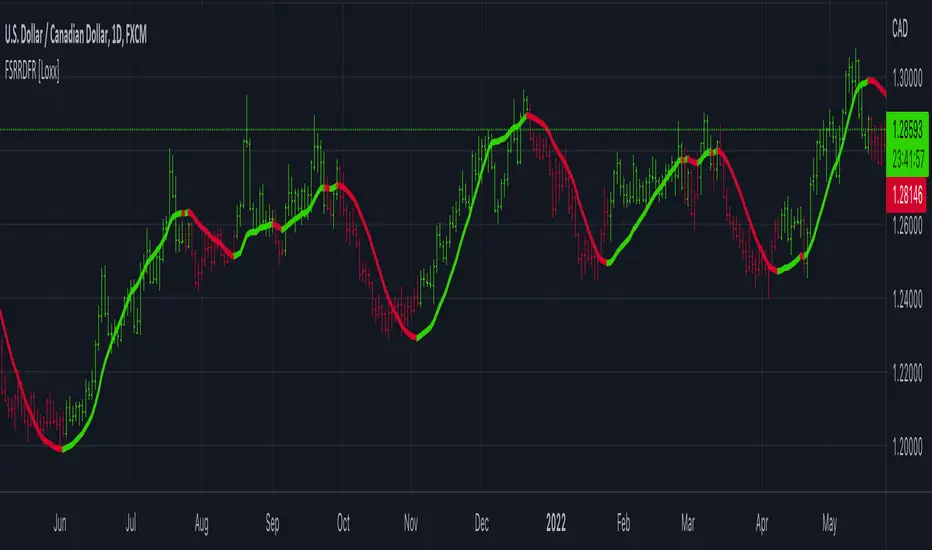OPEN-SOURCE SCRIPT
FATL, SATL, RFTL, & RSTL Digital Filters Raw [Loxx]

FATL, SATL, RFTL, & RSTL Digital Filters Raw [Loxx] is an indicator to showcase FATL, SATL, RFTL, & RSTL Digital Filters with their raw output values. The coefficients used here are for an idealized environment. This is tuned for Forex.
What is FATL?
FATL (Fast Adaptive Trend Line) is calculated using low frequency digital filter (FLF-1).
FLF-1 filter is necessary for high frequency noises suppression and reduction of market cycles with a very short volatility periods that can also be considered as a noise.
Filters of low frequency FLF-1 and FLF-2 provide attenuation in the stop band with no less than 40 dB and absolutely don’t distort the amplitude and phase of entry discontinuous price series in the pass band (bandwidth). These properties of the digital filters provide significantly improved (in comparison with simple moving average) noise suppression that in its turn allows reducing sharply the probability of appearance "false" signals for buy and sell.
There are no analogues to FATL among widely known technical instruments. It is not a moving "average", but just the adaptive lines estimates of the short-term trends. Unlike moving "average", FATL has no any phase delay with regard to current prices.
What is SATL?
Slow Adaptive Trend Line (SATL) is formed with the digital filter of the low frequency FLF-2.
Filter FLF-2 serves to suppress noises and market cycles with longer periods of oscillation. Filters of low frequency FLF-1 and FLF-2 provide attenuation in the stop band with no less than 40 dB and absolutely don’t distort the amplitude and phase of entry discontinuous price series in the pass band (bandwidth).
These properties of the digital filters provide significantly improved (in comparison with simple moving average) noise suppression that in its turn allows reducing sharply the probability of appearance of "false" signals for purchase and sell.
There are no analogues to SATL among widely known technical instruments. This is not a moving "average", but just the adaptive line estimate of a long-term trend.
Unlike moving average, SATL has no any phase delay with regard to current prices.
What is RFTL?
Reference Fast Trend Line (RFTL) is a response of FLF-1 and FLF-2 digital filters to the input discrete sequence. This response is set with the delay equal to the Nyquist TNi range.
RFTL reference line is an equivalent of simple moving "averages" from the viewpoint of their delay relative to the current prices. Mentioned similarity would have been complete, in case we use an impulse parameter having 1/N weights that corresponds to the procedure of the dotted moving smoothing instead of the complicated FLF impulse parameters.
What is RSTL?
Reference Slow Trend Line (RSTL) is a response of the SATL digital filter to the series of input prices with a delay equal to the Nyquist interval of 1/2F.
What is FATL?
FATL (Fast Adaptive Trend Line) is calculated using low frequency digital filter (FLF-1).
FLF-1 filter is necessary for high frequency noises suppression and reduction of market cycles with a very short volatility periods that can also be considered as a noise.
Filters of low frequency FLF-1 and FLF-2 provide attenuation in the stop band with no less than 40 dB and absolutely don’t distort the amplitude and phase of entry discontinuous price series in the pass band (bandwidth). These properties of the digital filters provide significantly improved (in comparison with simple moving average) noise suppression that in its turn allows reducing sharply the probability of appearance "false" signals for buy and sell.
There are no analogues to FATL among widely known technical instruments. It is not a moving "average", but just the adaptive lines estimates of the short-term trends. Unlike moving "average", FATL has no any phase delay with regard to current prices.
What is SATL?
Slow Adaptive Trend Line (SATL) is formed with the digital filter of the low frequency FLF-2.
Filter FLF-2 serves to suppress noises and market cycles with longer periods of oscillation. Filters of low frequency FLF-1 and FLF-2 provide attenuation in the stop band with no less than 40 dB and absolutely don’t distort the amplitude and phase of entry discontinuous price series in the pass band (bandwidth).
These properties of the digital filters provide significantly improved (in comparison with simple moving average) noise suppression that in its turn allows reducing sharply the probability of appearance of "false" signals for purchase and sell.
There are no analogues to SATL among widely known technical instruments. This is not a moving "average", but just the adaptive line estimate of a long-term trend.
Unlike moving average, SATL has no any phase delay with regard to current prices.
What is RFTL?
Reference Fast Trend Line (RFTL) is a response of FLF-1 and FLF-2 digital filters to the input discrete sequence. This response is set with the delay equal to the Nyquist TNi range.
RFTL reference line is an equivalent of simple moving "averages" from the viewpoint of their delay relative to the current prices. Mentioned similarity would have been complete, in case we use an impulse parameter having 1/N weights that corresponds to the procedure of the dotted moving smoothing instead of the complicated FLF impulse parameters.
What is RSTL?
Reference Slow Trend Line (RSTL) is a response of the SATL digital filter to the series of input prices with a delay equal to the Nyquist interval of 1/2F.
สคริปต์โอเพนซอร์ซ
ด้วยเจตนารมณ์หลักของ TradingView ผู้สร้างสคริปต์นี้ได้ทำให้เป็นโอเพนซอร์ส เพื่อให้เทรดเดอร์สามารถตรวจสอบและยืนยันฟังก์ชันการทำงานของมันได้ ขอชื่นชมผู้เขียน! แม้ว่าคุณจะใช้งานได้ฟรี แต่โปรดจำไว้ว่าการเผยแพร่โค้ดซ้ำจะต้องเป็นไปตาม กฎระเบียบการใช้งาน ของเรา
Public Telegram Group, t.me/algxtrading_public
VIP Membership Info: patreon.com/algxtrading/membership
VIP Membership Info: patreon.com/algxtrading/membership
คำจำกัดสิทธิ์ความรับผิดชอบ
ข้อมูลและบทความไม่ได้มีวัตถุประสงค์เพื่อก่อให้เกิดกิจกรรมทางการเงิน, การลงทุน, การซื้อขาย, ข้อเสนอแนะ หรือคำแนะนำประเภทอื่น ๆ ที่ให้หรือรับรองโดย TradingView อ่านเพิ่มเติมใน ข้อกำหนดการใช้งาน
สคริปต์โอเพนซอร์ซ
ด้วยเจตนารมณ์หลักของ TradingView ผู้สร้างสคริปต์นี้ได้ทำให้เป็นโอเพนซอร์ส เพื่อให้เทรดเดอร์สามารถตรวจสอบและยืนยันฟังก์ชันการทำงานของมันได้ ขอชื่นชมผู้เขียน! แม้ว่าคุณจะใช้งานได้ฟรี แต่โปรดจำไว้ว่าการเผยแพร่โค้ดซ้ำจะต้องเป็นไปตาม กฎระเบียบการใช้งาน ของเรา
Public Telegram Group, t.me/algxtrading_public
VIP Membership Info: patreon.com/algxtrading/membership
VIP Membership Info: patreon.com/algxtrading/membership
คำจำกัดสิทธิ์ความรับผิดชอบ
ข้อมูลและบทความไม่ได้มีวัตถุประสงค์เพื่อก่อให้เกิดกิจกรรมทางการเงิน, การลงทุน, การซื้อขาย, ข้อเสนอแนะ หรือคำแนะนำประเภทอื่น ๆ ที่ให้หรือรับรองโดย TradingView อ่านเพิ่มเติมใน ข้อกำหนดการใช้งาน